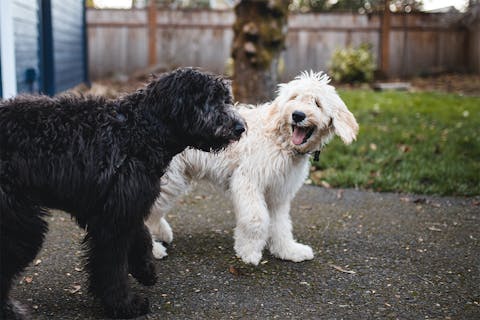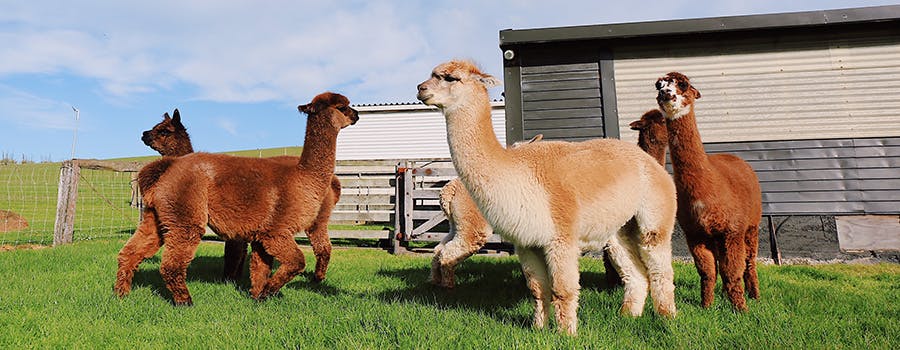Updated 18th September 2025.
Learn how to help dog allergies in this vet-approved guide to food allergies in dogs, allergies to pests, mites, dust and seasonal allergies. Learn the symptoms of allergies reactions in dogs, and how to prevent dog allergies.
How to help dog allergies: prevention and treatment
Helping a dog with allergies starts with prevention. If you suspect your dog has an allergy, speak to your vet for advice and avoid exposing them to the allergen if you can. Prevention can look like swapping out a certain food, or flea treatments - it really depends on the type of allergy your dog has. Below, we’ll explore some of the possible treatments vets may provide for dogs with allergies:
Allergy treatments for dogs
- Fatty acid supplements. Some vets may prescribe fatty acid supplements to help boost your dog’s immune system.
- Medication or allergy shots. Vets may be able to provide allergy shots or medications as a long-term solution for relief, especially if it’s an allergy they experience all year round.
- Remember each dog’s allergy treatment is unique. Each treatment will be unique to your dog, their lifestyle and the allergy they have, so chat with their vet and create a healthy helping plan together.
Trending posts
Purr-use some of the top blogs our members have been loving this month- Top male dog names for your new furry friendGot a new furry family member in your pack? Check…

- Top female dog names for your new fluffy palWelcoming a new pooch into your family? Explore…

- 250+ gray cat names your silver feline will loveRecently welcomed a fluffy gray bundle of joy into…

- What are normal pet sitting rates?Discover the average pet sitting rates for animals…

- Unique dog names to stand out from the packDare to be different with our list of the best…

Types of allergies in dogs
Dog allergies can be something they inherited or were born with, and they can develop after a serious illness when their immune system is more susceptible to infections and reactions.
To understand how to help dog allergies, let’s explore the different types of allergies in dogs - here are some of the most common dog allergies most often seen by vets:
Seasonal allergies in dogs to pollens, molds, and hayfever
Seasonal allergies are the most commonly seen allergy in dogs (and humans). The start of spring or a freshly mowed lawn could be all it takes to trigger your dog’s allergies.
Common symptoms of seasonal allergies in dogs:
- Sneezing
- Swollen face
Just a quick note - you may also see swelling in your dog’s face from insect stings or bites - contact your vet either way.
What to do if you think your dog has seasonal allergies:
Take them straight to the vet, they’ll be able to administer an anti-allergy shot which will make the swelling disappear almost immediately.
Dog allergies to dust mites, fleas, and other pests
Dust mites and fleas often bite dogs and can cause a series of irritating reactions.
Common symptoms of dog allergies to dust mites and fleas:
- Itchy skin
- Constant scratching in one place.
- Skin can become red and damaged due to scratching which can lead to fungal or bacterial infections.
Common treatments for allergies to dust mites and fleas in dogs:
The first port of call should be your vet for an assessment. Here are some common approaches vets might take to treat your dog’s allergy to dust mites and fleas:
- Shampoo. Vets will often recommend topical shampoo to soothe your dog’s skin and deter any pests.
- Flea collars. Your vet may also be able to provide flea collars designed for sensitive skin.
- Regular treatments. Your vet may also be able to provide monthly flea and pest treatments.
Other skin or contact allergies in dogs
If you’ve recently changed your washing detergent, perfume or body wash and notice a change in your dog’s behavior or health, this could be a clear sign they’re suffering from a contact allergic reaction. If you suspect a reaction in your dog, contact your vet.
Food allergies in dogs
Just like us humans, dogs can suffer from allergies to certain foods.
Symptoms of food allergies in dogs:
- Vomiting or diarrhea (most common)
- Irritated skin
- Convulsions
What to do if you think your dog has a food allergy:
- Contact your vet. Start by speaking with your vet - they might be able to recommend a way to understand what your dog is allergic to.
- Consider switching up their food. Some dog food brands offer a hypoallergenic formula, but be sure to check this with your vet first. Similarly, never suddenly change your dog’s diet without first slowly introducing a new food.
Symptoms of allergic reactions in dogs
Every dog is different, meaning each dog will present a different list of symptoms of an allergic reaction. However, there are some common and key signs of allergies in dogs that are a big red flag to look out for:
- Itch skin or irritated skin
- Runny nose
- Persistent sneezing
- Vomiting
- Diarrhea
- Itchy, swollen, and/or itchy eyes
- Swelling around the head
- Itchy ears
- Constantly licking one particular area
If your dog suddenly starts displaying any of the above symptoms, or you notice any change in their behavior or mood, take them straight to their vet. Whilst these symptoms are the most common in dogs with allergies, some allergies may appear differently.
Meet our veterinary expert, Greg
This article has been checked by veterinarian Dr Greg Steele MA VETMB MRCVS. A mixed vet working in the UK since qualifying from Cambridge University in 2015. Greg enjoys working with all species of animals in all settings, but equally takes pride in communication and education of clients too. He lives with his wife and their cat, and enjoys a variety of sports, gardening, and the great outdoors.
If you’re one of our Premium or Standard members, you have free access to our 24/7 Vet Advice Line to call if you ever have any pet questions or concerns. Not a member yet? Well, why have a little look at our different pricing plans to see which one suits you?

